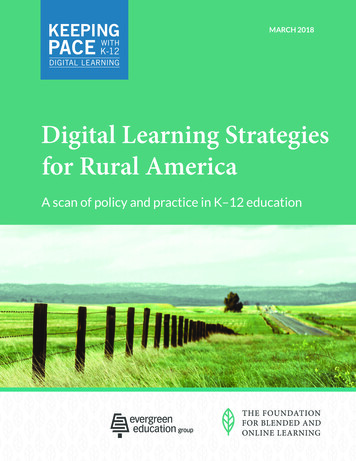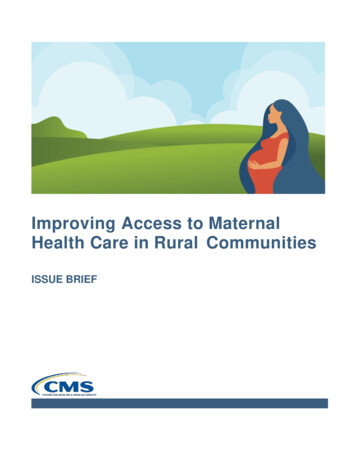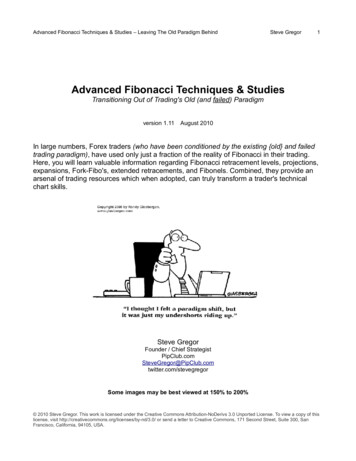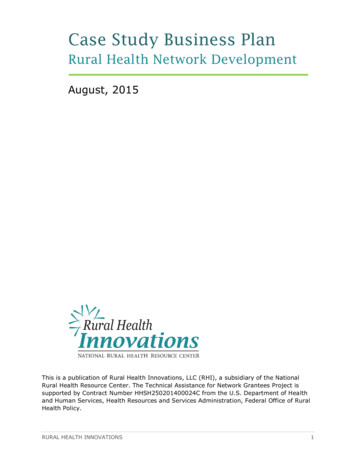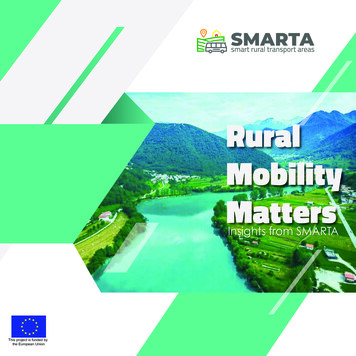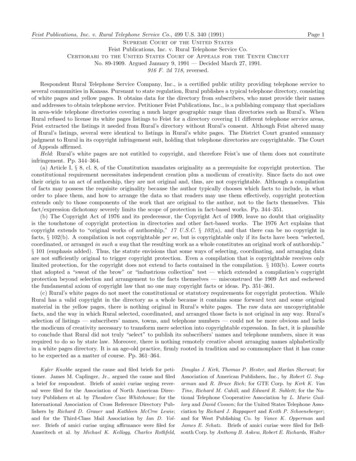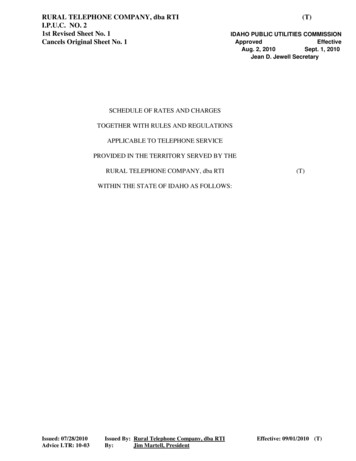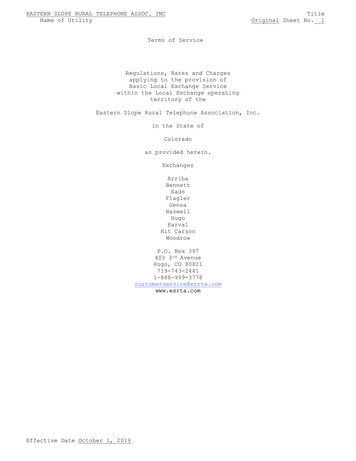
Transcription
A NEW RURAL DEVELOPMENTPARADIGM FOR DEVELOPINGCOUNTRIES IN THE 21ST CENTURYCarl DahlmanOECD Development CentreNew YorkSeptember 26, 2015
Why a new rural developmentparadigm? More than 3.3 billion people live in rural areas andthis number will remain around 3.2 billion past2050 92% of the population in developing countries livein rural areas and this share will continue to rise More than 60% of the rural population indeveloping countries is below USD 2.00 PPP/day Developing countries need better strategies to dealwith large and growing rural populations Effective rural development strategies are going tobe necessary to achieve the SustainableDevelopment Goals
Total rural population will continue toincrease until 2028Less developed regionsRural Population 00,0001,500,0001,000,000500,0000More developed regions
Population growth rates in the developingworld (1950-2050)Population Growth RatesWorldSub-Saharan AfricaSouthern AsiaSoutheast 199520002005201020152020202520302035204020452050
Poverty rates between rural and urbanareas in developing countries (1990-2008)East Asia and PacificMiddle East and North AfricaSouth AsiaSub-Saharan 08
Challenges and opportunities fordeveloping countries todayChallenges Demographic pressure, 370 million additional youth will join thelabour market in Sub-Saharan Africa within 15 years More competitive global context limits many previous opportunities Climate change, higher vulnerability to droughts and water stress Rural-to-urban migration with limited productive jobsOpportunities New links and lower costs to international trade and access toglobal supply-chains. New technologies: Green Revolution, ICT-enabled services, betteraccess to and exchange of information for rural populations (mustbe leveraged on other policy actions) Rural industry, education and health services, tourism
Different trajectories: OECD, Korea,developing countriesEmployment in agriculture vs rural population%9080Developing World706050Korea403020100OECD Countries: % rural population----: % employment in agriculture
Korea’s rural development strategy:Saemaul Undong Context: Fast industrialisation and demographic transition, highrural-to-urban migration flow, and egalitarian rural society. Saemaul Undong: Buffer during the transition from an agrarian toa modernised rural society during fast structural transformation. Agents: All levels of government; private sector; and village leaders Country assets: pre-existence of high social capital in ruralcommunities; resources from government-led industrialisationprocess, and strong leadership and commitment from central govt. Main strategy:– Top-down actions to mobilise communities, along with bottom-upactions to identify local priorities and carry out projects to build orimprove infrastructure.– Inter-ministerial coordination for improving agricultureproductivity and promoting non-farm employment in rural areas
Lessons from the Korean ruraldevelopment experienceRural development strategies should have: A broad multi-sectoral approach that alinfrastructure, education and health, and income support,with strong coordination mechanisms Incentives for mobilising the rural community toimprove basic infrastructure and living conditions Mechanisms for building local capabilities andmonitoring and evaluating local projects on and promote coordination acrossstakeholders Sharing of best practices to contribute to learningand to adapting new actions to improve programimplementation
Key lessons from the study including 5developing country experiences1.2.3.4.5.Successful rural development strategies have to be tailored to thespecific conditions of each countryThe biggest challenge in developing and implementing successfulrural development strategies is governance, particularly thecapacity to integrate, coordinate, implement, monitor and adjuststrategies to constantly changing circumstancesDemographic structure and demographic trends need to be takeninto account because they have big implications for the economicopportunities and welfare of the population (see next slide).Need to switch from static definition of “rural” and “urban” towardmultidimensional policies that incorporate rural areas intoregional development and build on positive dynamics of ruralurban linkagesCountry strategies need to carefully consider the appropriatebalance between the roles of agriculture, industry and services inrural development
Income per capita, urbanisation andtotal fertility per women (1960-2012)GDP per capita PPP inflation-adjusted35,000KoreaChinaCôte d Ivoire30,000VietnamThailandTanzania25,000TFR 720,000TFR 3.515,000TFR 110,000CIV 19605,000VNM 19600THA 1960KOR 1960CHN 1960TZA 1960-5,0000102030405060708090Urban Population (% of total)
The New Rural Development Paradigm Stresses distinct policies for the agricultural, industrial, andservices sectors, and incorporates social policies that gobeyond economic ones Considers the inter-dependencies between rural and urbanareas to give policies a cross-regional dimension Aims to reduce both spatial- and gender-based inequalities Builds around the unique characteristics, challenges, andadvantages of particular countries Takes into account the capacity of government to design andimplement policies and the need for building in appropriateincentives for different actors and buy-in for implementation Takes into account the need to constantly adapt strategies tochanging local and global context, and to build local capability
Toolkit for rural development Set of policies that can help achieve ruraldevelopment objectives Assessment of country specifics in order todevelop a strategy Considerations for developing strategies Basic classification matrix Key points to keep in mind
Illustrative policies for rural developmentAgriculture1.2.3.4.5.6.Modernizing agricultureInserting agriculture into globalvalue chainsDeveloping agricultural pricingpoliciesImproving productivity andresilience of subsistenceagricultureImproving food securityDeveloping land policiesIndustry1.2.3.4.2.3.4.5.6.Investing in education andtrainingInvesting in basic healthMainstreaming gender issues indevelopmentEncouraging family planningPromoting social capitalPromoting community- drivendevelopment projects1.2.3.4.5.Human and Social Capital1.Promoting industrial zonesPromoting rural industryPromoting handicrafts andcottage industryPromoting basic physicalinfrastructure investmentsServicesGovernment1.2.3.4.5.Building government capacity atdifferent levelsIncreasing the role of ruralurban linkages in broaderdevelopment strategiesSupporting governmenttransfersDeveloping intermediary citiesManaging internal and externalmigrationPromoting private-sector serviceindustriesImproving transport logisticsPromoting access and use ofinformation andcommunications technologyPromoting access to credit,inputs and marketsPromoting tourism and ecotourismEnvironment1.2.Mainstreaming environmentalsustainabilityBuilding resilience
Considerations for developing strategies Institutional and structural issues such as the level ofgovernment capacity, population dynamics, environmentalvulnerability (see benchmarking slides) Prioritising and sequencing what is to be done, taking intoaccount the priorities of different stakeholders Sources of financing, including the roles played by domesticresource mobilisation, the effective tapping of naturalresource rents, foreign direct investment, foreign borrowingand foreign assistance, and remittances from internationalmigrants. The incentives for different agents to participate in thestrategy The role for new technological opportunities and how to tapthem effectively Monitoring, accountability and capacity for adjustment
Criteria for Country ClassificationCountries have been classified according to the following criteria: Rural Population Share: rural population higher than 67%, between 34% and 67% and less than 34% Natural Resources: natural resources rents (excluding forestry) accounting for more or less than 10% of GDP Demography: Total Fertility Rates (TFR) divided into five categories from higher than 5 to lower than 2 births perwoman. State Fragility: countries are color-coded according to their level of fragility and classified as: Very High Alert,High Alert, Alert, Very High Warning, High Warning, Warning, Less Stable, Stable and Very Stable.Our Index is adapted from the existing Fragile States Index but includes only the following relevant six dimensions: 4. Security Apparatus2. Legitimacy of the State5. Factionalised Elites3. Human Rights6. External InterventionClimate Change Vulnerability: the underlined countries are the ones with a high score in the vulnerability toclimate change index (higher than 0.50), as derived from the Notre Dame Global Adaptation Index.Vulnerability is measured by considering six life-supporting sectors and three components within each of them.Six life-supporting sectors1. Food2. Water3. Health4. Ecosystem Services5. Human Habitat6. Infrastructure 1. Group GrievanceThree components within each sectora. Exposure of the sector to climate-related or climate-exacerbated hazardsb. Sensitivity of that sector to the impacts of the hazardc. Adaptive capacity of the sector to cope with or adapt to these impactsLandlocked countries: the asterisk indicates when a country is landlocked.
Classification MatrixRural population 67%Natural resource rents 10%of GDPTFR 5Natural resource rents 10% ofGDPNatural resource rents 10% ofGDPBurkina Faso*Chad*GambiaMali*SomaliaAngolaCongo, Dem. aMozambiqueRwanda*TanzaniaEritreaSouth Sudan*BeninCameroonCôte a LeoneSudanTogoCongoEquatorial mbabwe*Papua New GuineaCentral African Republic*GuatemalaSao Tome and PrincipeGhanaYemen, Rep.Burundi*Malawi*Niger*Timor-LesteUganda*Natural resource rents 10% of GDP34% Rural population 66%4 TFR 53 TFR 4Note: here we focus only on countries with more than 34% of population living in rural areas.
Classification Matrix (cont.)NaturalGDPresourceRural population 67%34% Rural population 66%rents 10% of Natural resource rents 10% of Natural resource rents 10% of Natural resource rents 10% ofGDPGDPGDP2 TFR 3BangladeshCambodiaIndiaLesotho*Nepal*Sri LankaTFR 2Viet NamGuyanaBelizeBhutan*Botswana*Cabo VerdeEl SalvadorGrenadaHaitiHondurasIndonesiaJamaicaKyrgyz guay*PhilippinesSeychellesSouth AfricaSyrian Arab RepublicEcuadorEgypt, Arab Rep.Kazakhstan*Lao PDR*Turkmenistan*Uzbekistan*AlbaniaArmenia*Bosnia and HerzegovinaChinaGeorgiaMacedonia, a*ThailandAzerbaijan*
Key points to keep in mind Strategies have to be tailored to the specifics ofeach country’s situation This requires detailed assessment and knowledgeof the local context. It is not a process that can bedone from abroad. It requires deep local knowledge and consultationsand negotiations with relevant local agents Development and implementation of effectivestrategies requires improving the capability ofgovernment at all levels and of other key actors, aseven the best strategies need to be adjusted overtime as circumstances change
Moving forward The New Rural Development Paradigm for the 21st century can be used as a tool foridentifying some of the challenges and proposing some of the solutions to achievingthe Sustainable Development Goals (SDGs) In the process of developing it we have identified some major challenges beyondclimate change which will require concerted national and international action– Addressing very high population growth in many countries, particularly in SubSaharan Africa– Need to create massive productive employment– Need to improve governance, and government capability– Need to improve donor coordination– Need to develop greater resilience in developing country Addressing some of these challenges will require– New innovative approaches including new technologies, organization and waysof implementing strategies– More efforts to build local capability in governments at all levels, but also in theprivate and NGO sector– Greater international coordination and more effective ways of engagement
The New Rural Development Paradigm for the 21st century can be used as a tool for identifying some of the challenges and proposing some of the solutions to achieving the Sustainable Development Goals (SDGs) In the process of developing it we have identified some major challenges beyond


